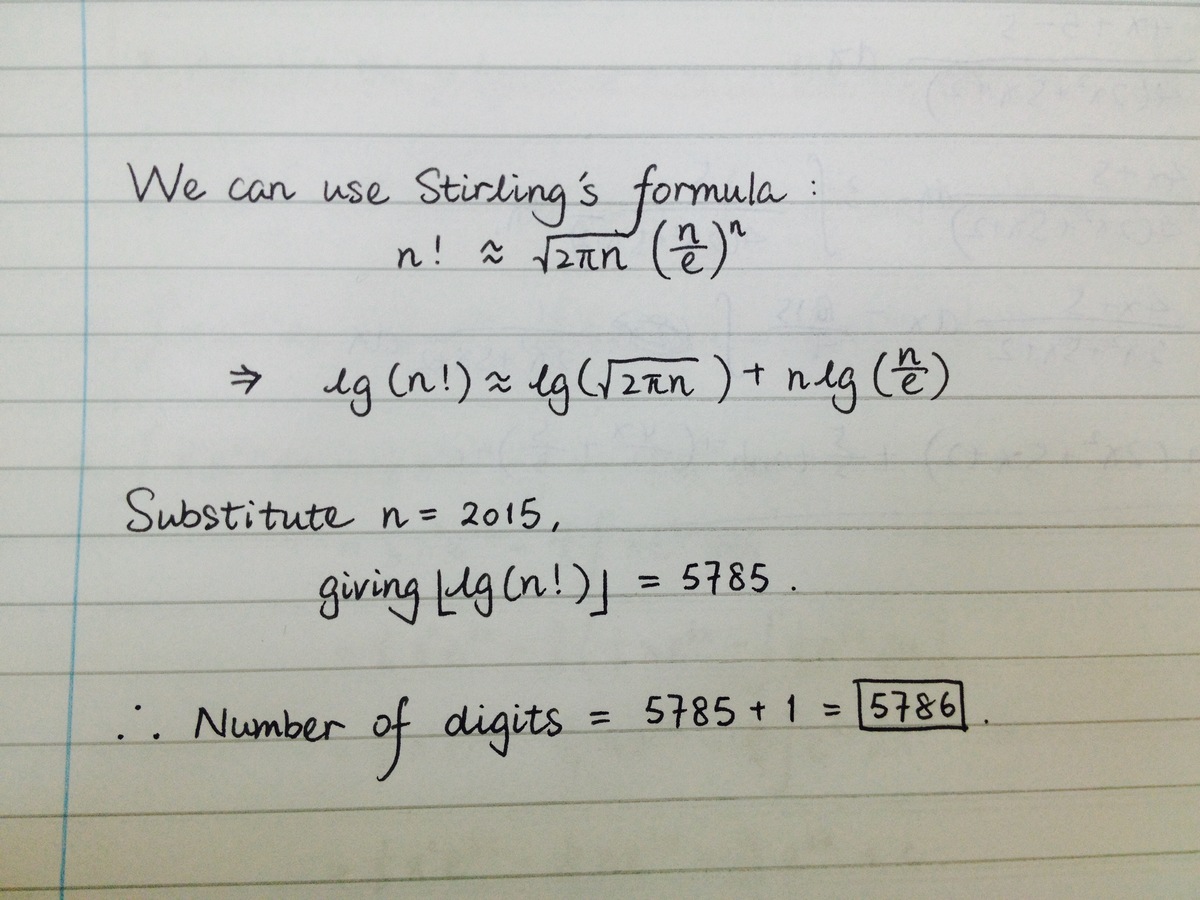This section requires Javascript.
You are seeing this because something didn't load right. We suggest you, (a) try
refreshing the page, (b) enabling javascript if it is disabled on your browser and,
finally, (c)
loading the
non-javascript version of this page
. We're sorry about the hassle.
4 solutions

Why did you use the floor function first, then added +1 instead of using ceiling function from the beginning? Also the first few lines seem redundant to me, though I admit seeing Stirling's formula in action is always exciting.
Log in to reply
Alisa Meier "Why did you use the floor function first, then added +1 instead of using ceiling function from the beginning?" -- Consider the situation where it is an integer. "Also the first few lines seem redundant to me [...]" -- For me , they are not redundant, as I think they help to explain the following steps. Moreover, a normal calculator cannot calculate l g ( 2 0 1 5 ! ) directly.
P.S. You can always do this problem afterwards and also see the solution there.
Log in to reply
Moreover, a normal calculator cannot calculate lg ( 2 0 1 5 ! ) directly.
Write as lo g ( 2 0 1 5 ! ) = k = 1 ∑ 2 0 1 5 lo g k Though my calculator took five minutes just to evaluate that. XD
I was not aware of stirling's formula before, so this helped me
1 2 3 4 5 6 7 8 9 10 11 12 13 |
|
:D
nice problem, just use Euler's Formula
How's that?
Log in to reply
There should be a way solving this via the Euler-Maclaurin formular. (my proof is yet incomplete)
Let M be the numbers of digits we look for. Then we have M = 1 + ⌊ l o g 1 0 l o g ( 2 0 1 5 ! ) ⌋
Problem is dealing with the l o g ( 2 0 1 5 ! )
Now one can use Stirling's formular as done by @Jessica Wang
Or go via the Euler-Maclaurin formular: lo g ( 2 0 1 5 ! ) = k = 1 ∑ 2 0 1 5 lo g ( k ) =
∫ 1 2 0 1 5 lo g ( x ) d x + ∫ 1 2 0 1 5 ( x − ⌊ x ⌋ ) x 1 d x + lo g ( 2 0 1 5 ) ( ⌊ 2 0 1 5 ⌋ − 2 0 1 5 ) − l o g ( 1 ) ( ⌊ 1 ⌋ − 1 )
= ( 2 0 1 5 ∗ lo g ( 2 0 1 5 ) − 2 0 1 4 ) + ( 2 0 1 4 − ∫ 1 2 0 1 5 x ⌊ x ⌋ d x )
At this point however I don't see a convenient dealing with the last integral. It would be nice to see this finished somehow.
Good work everyone.. I used stirling's formula..